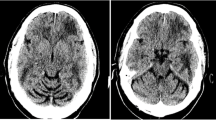Abstract
Posterior reversible encephalopathy syndrome (PRES) is a neurotoxic state which is characterized by seizures, headache, visual disturbances, paresis, and altered mental status. Golimumab is anti-tumor necrosis factor-α inhibitor (anti-TNF-α) that can be used in the treatment of rheumatologic diseases. Here, we present a patient who had developed PRES after golimumab treatment for ankylosing spondylitis (AS). A 45-year-old female patient was admitted to the emergency service with a newly onset severe headache, loss of vision in both eyes, and two generalized tonic–clonic seizures that lasted for 3 to 4 min. The patient had the diagnoses of AS for 12 years and hypertension for 3 years and receiving golimumab and carvedilol. The patient was diagnosed with PRES based on the current clinical and diffusion cranial magnetic resonance imaging (MRI) findings. On suspicion of being the trigger of this situation, golimumab was stopped. After starting anti-convulsant therapy and controlling blood pressure, the neurological findings recovered rapidly and no seizures were seen. Control MRI images, in the first month’s visit, were normal. Although chemotherapeutic agents are well-known causes of PRES, there are few reported cases with anti-TNF-α agents in the literature. To our knowledge, this is the first case that developed PRES after golimumab. Demyelinating diseases are the most frightening neurologic complication of anti-TNF-α treatment; however, PRES should come to mind in patients presenting with neurological symptoms.

Similar content being viewed by others
Data availability
No additional data available.
References
Hinchey J, Chaves C, Appignani B, Breen J, Pao L, Wang A, Pessin MS, Lamy C, Mas JL, Caplan LR (1996) A reversible posterior leukoencephalopathy syndrome. N Engl J Med 334:494–500. https://doi.org/10.1056/NEJM199602223340803
Budhoo A, Mody GM (2015) The spectrum of posterior reversible encephalopathy in systemic lupus erythematosus. Clin Rheumatol 34:2127–2134. https://doi.org/10.1007/s10067-015-3055-2
Tekşam M, Casey SO, Michel E, Truwit CL (2001) Posterior reversibl ensefalopati sendromu: patofizyoloji ve ileri MRG teknikleri ile korelasyon. Diagn Interv Radiol 7:464–472
Mahévas T, Lidove O, Yahia SA, Hayet S, Xerri-Campano B, Ziza JM (2016) Posterior reversible encephalopathy syndrome (PRES) in a patient taking adalimumab for spondyloarthritis. Joint Bone Spine 83:243–244. https://doi.org/10.1016/j.jbspin.2015.08.002
Kastrup O, Diener HC (2008) TNF-antagonist etanercept induced reversible posterior leukoencephalopathy syndrome. J Neurol 255:452–453. https://doi.org/10.1007/s00415-008-0732-y
Haddock R, Garrick V, Horrocks I, Russell RK (2011) A case of posterior reversible encephalopathy syndrome in a child with Crohn’s disease treated with Infliximab. J Crohns Colitis 5:623–627. https://doi.org/10.1016/j.crohns.2011.06.011
Zamvar V, Sugarman ID, Tawfik RF, Macmullen-Price J, Puntis JW (2009) Posterior reversible encephalopathy syndrome following infliximab infusion. J Pediatr Gastroenterol Nutr 48:102–105. https://doi.org/10.1097/MPG.0b013e31818aedb4
Chow S, Patnana S, Gupta NK (2016) Posterior reversible encephalopathy syndrome in a patient with Crohn’s disease on infliximab. J Clin Gastroenterol 50:687. https://doi.org/10.1097/MCG.0000000000000557
Zamvar V, Puntis JW (2010) Re: “Posterior reversible encephalopathy syndrome following infliximab infusion.” J Pediatr Gastroenterol Nutr 50:353. https://doi.org/10.1097/MPG.0b013e3181a9f95d
Floeter AE, Patel A, Tran M, Chamberlain MC, Hendrie PC, Gopal AK, Cassaday RD (2017) Posterior reversible encephalopathy syndrome associated with dose-adjusted EPOCH (etoposide, prednisone, vincristine, cyclophosphamide, doxorubicin) chemotherapy. Clin Lymphoma Myeloma Leuk 17:225–230. https://doi.org/10.1016/j.clml.2016.12.004
Covarrubias DJ, Luetmer PH, Campeau NG (2002) Posterior reversible encephalopathy syndrome: prognostic utility of quantitative diffusion-weighted MR images. AJNR Am J Neuroradiol 23:1038–1048
Legriel S, Pico F, Azoulay E (2011) Understanding posterior reversible encephalopathy syndrome. In: Vincent JL (ed) Annual update in intensive care and emergency medicine 2011. Springer, Berlin, Heidelberg, pp 631–653. https://doi.org/10.1007/978-3-642-18081-1_56
Author information
Authors and Affiliations
Contributions
EÇG provided the conception of the study, literature search, and interpretation of data, drafting the article. Additionally, all authors revised the article critically for important intellectual content and gave final approval of the version to be submitted.
Corresponding author
Ethics declarations
Disclosures
None.
Informed consent
Information concerning the manuscript was provided to the patient. Written informed consent was obtained from the patient for publication of this case report and any accompanying images.
Additional information
Publisher's note
Springer Nature remains neutral with regard to jurisdictional claims in published maps and institutional affiliations.
Rights and permissions
Springer Nature or its licensor (e.g. a society or other partner) holds exclusive rights to this article under a publishing agreement with the author(s) or other rightsholder(s); author self-archiving of the accepted manuscript version of this article is solely governed by the terms of such publishing agreement and applicable law.
About this article
Cite this article
Çimen Güneş, E., Çolak, S., Tekgöz, E. et al. Golimumab-induced posterior reversible encephalopathy syndrome (PRES): a case-based review. Clin Rheumatol 42, 3407–3410 (2023). https://doi.org/10.1007/s10067-023-06771-w
Received:
Revised:
Accepted:
Published:
Issue Date:
DOI: https://doi.org/10.1007/s10067-023-06771-w




